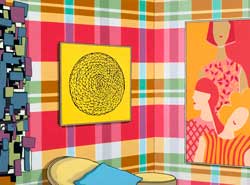JIM RICHARD
by John Zotos, ART LIES
A suite of new, large-scale paintings by Jim Richard reveals an artist at the height of his powers of composition and technique. Richard’s work playfully confounds any attempt at art “isms”; instead, he reflects our image-saturated world through the use of pattern. In Richard’s hand, pattern identifies, outlines and inscribes space as volume without texture. His consistent concern with interior space seems to put forth space itself as confused, sometimes compressed and so often groundless or unreal that the notion of observation revels in paradox.

Plaid, 2006
Richard plays off of reality but deals in fiction. Objects of interior design such as lamps, fixtures and furniture lose their currency as parts of reality. Likewise, the paintings and sculptures in his interiors approximate modernist objects but reveal themselves as fabrications the closer one looks. For Richard, the position of the viewer provides an implied human presence within the compositions. This identifies another constant in his work: every painting lacks actual bodies, as if people get in the way of the project. Richard one-ups Alain Resnais and Robbe-Grillet, taking a larger leap toward depopulation while acknowledging a common preoccupation with mystery, environment and French Surrealism.
In Crowded Entrance, a large vertical canvas confronts each visitor, mirroring the small gallery foyer that opens into the main space. In this painting, an antique bust on a long pedestal blocks what looks like a doorway, making the passage feel off-limits. The door, like the black and white checkered floor, references grid patterns with criss-crossing lines—Mondrian comes to mind. With a white background and green and black stripes, Richard’s patterned door is revealed by a knob and frame, and flanked by a curtain on the right and the building’s own architecture to the upper left. These framing devices situate the statue in the middle of the composition and heighten the anxiety attached to space. Such an arrangement could not functionally exist in reality; consequently, the sense of confinement pressed into the statue leaves one unsettled. Richard’s handling of paint makes the surface flat, cartoonlike and somewhat surreal.
Similar spatial distortions occur in Dark Landing. A spiral staircase in the foreground situates the viewer’s vantage point—distanced observation of a drawing room crowded with objects. Richard’s concern here, far from related to actual living space, rests in the relationship between the statues, fixtures and furniture and how a psychological space emerges.
For example, a blurry, eerie surface characterizes the mantelpiece; a lion sculpture in the background stares over his dominion. Does he remind us of Rousseau’s feline motifs? This out of focus surface repeats throughout the composition, forming a circle. Beyond the lion, it appears in a chandelier that compresses the space with a downward force. The partial view of a nude frames the right and two modern statues with pedestals stand in the center atop a table. These surfaces are positive and bright—a counter to the dark, negative spaces of the stairwell landing (hence the title). In all, Richard’s adroit handling of line unifies the images and lends a flat, pop sensibility to the canvas while the painted portions allude to shadow and reflection, keeping the viewer’s eye wandering, perhaps seeking a way through this dense panorama.
A preponderance of pattern and line dominate Wrap Around Green—a long, horizontal painting of an interior space is cropped from ceiling to middle ground, eliminating the foreground. Here, the left half of the canvas deals in volume—the three-dimensional space formed by green walls covered in a monotonous wallpaper pattern. In the middle of this enclosure rests a blue rhomboid, the only solid mass in a sea of pattern. On the right side, the space compresses into a two-dimensional world—or does it? A third dimension is faintly revealed by a table that juts into the lower right. Atop the table stands an abstract sculpture that looks much like Duchamp’s Bachelors or a Henry Moore, bringing another paradox into the equation of appearance vs. being.
Richard constantly problematizes spatial relationships, but not with a deconstructive, postmodern agenda. Rather, the images in the paintings layer and merge like the meeting of computer operations—windows, cut and paste, photomontage—leading back to associations with collage, his actual working method. Richard’s work brings into question the objective and so-called rational operations constantly at play in the material world.
